
Dhammayuttika Nikaya, or Thammayut is an order of Theravada Buddhist bhikkhus (monks) in Thailand, Cambodia, and Burma, with significant branches in the Western world. Its name is derived from Pali dhamma + yutti + ka (group). The order began in Thailand as a reform movement led by a prince who would later become King Mongkut of Siam, before also spreading to Cambodia and Burma. The movement became formally recognized as its own monastic order by the Thai government in 1902, with any Thai Theravada bhikkhus not within the order being referred to as part of the Maha Nikaya order. The Dhammayuttika Nikaya plays a significant political role in Thailand. The order has historically been favored by the Thai government and monarchy, with the order holding the majority of all royal monastic titles in Thailand and most of the Supreme Patriarchs since its founding having come from the Dhammayuttika Nikaya, despite the order making up less than ten percent of all bhikkhus in Thailand.
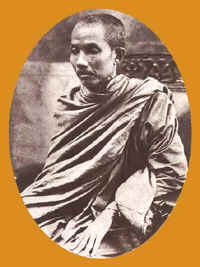
Vajirananavarorasa was the tenth Supreme Patriarch of Thailand from 1910 to 1921. He helped to institutionalize Thai Buddhism.

Buddhism in Thailand is largely of the Theravada school, which is followed by 95 percent of the population. Thailand has the second largest Buddhist population in the world, after China, with approximately 64 million Buddhists. Buddhism in Thailand has also become integrated with folk religion as well as Chinese religions from the large Thai Chinese population. Buddhist temples in Thailand are characterized by tall golden stupas, and the Buddhist architecture of Thailand is similar to that in other Southeast Asian countries, particularly Cambodia and Laos, with which Thailand shares cultural and historical heritage. Thai Buddhism also shares many similarities with Sri Lankan Buddhism. Thailand, Cambodia, Myanmar, Sri Lanka and Laos are countries with Theravada Buddhist majorities

Wat Phra Kaew is a third-common-class royal temple situated in the area of 10,640 square metres on Trairat road, Wiang sub-district, Muang Chiang Rai in Chiang Rai City, Thailand. The King of Thailand upgraded the temple to the royal temple on May 31, 1978. The temple gains historical importance as the place where the Emerald Buddha was found. It is also one of the main centres of Buddhist education and the Sangha's administration in northern Thailand.

Paramanuchitchinorot was a Buddhist writer and a prince of the Chakri dynasty. One of his well-known epic poems is Lilit Taleng Phai. In 1851 he was appointed the Supreme Patriarch of the Rattanakosin kingdom and remained in that position until his death.
The Dhammakaya tradition or Dhammakaya movement, sometimes spelled as Thammakaai movement, is a Thai Buddhist tradition founded by Luang Pu Sodh Candasaro in the early 20th century. It is associated with several temples descended from Wat Paknam Bhasicharoen in Bangkok.
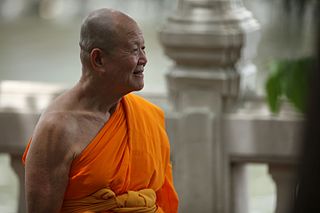
Luang Por Dattajivo, also known by his birth name Phadet Phongsawat and former ecclesiastical title Phrarajbhavanajahn, is a Thai Buddhist monk. He is the former deputy-abbot of Wat Phra Dhammakaya and the vice-president of the Dhammakaya Foundation, and was the observing abbot of the temple from 1999 until 2006, and again from 2011 until 2016. As of December 2016, he was still widely considered the de facto abbot. He met Mae chi (nun) Chandra Khonnokyoong and Luang Por Dhammajayo in his student years, and they have been his teachers throughout his life.
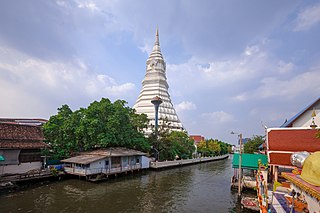
Wat Paknam Bhasicharoen is a royal wat ('temple') located in Phasi Charoen district, Bangkok, at the Chao Phraya River. It is part of the Maha Nikaya fraternity and is the origin of the Dhammakaya tradition. It is a large and popular temple, supported by prosperous community members.

Thai temple art and architecture is the art and architecture of Buddhist temples in Thailand. Temples are known as wats, from the Pāḷi vāṭa, meaning "enclosure." A temple has an enclosing wall that divides it from the secular world.

Mahachulalongkornrajavidyalaya University (MCU) is one of two public Buddhist universities in Thailand, as well as being the oldest Buddhist university in the nation. It has facilities at Wat Mahathat Yuwaratrangsarit in Bangkok and at Wang Noi in Ayutthaya Province.
Piya Tan Beng Sin, also known as Piya Tan or Piyasilo, is a Peranakan full-time lay Buddhist writer-cum-teacher in Singapore. He actively teaches the Buddha's Dharma, meditation and Pali to various Buddhist groups and organisations, and also works as a meditation therapist and counsellor at The Minding Centre (TMC). He is the first full-time lay Dharma worker ("Dharmacari") in Singapore to be supported by donations from the Buddhist community.
Prayudh Payutto, also known by his current monastic title, Somdet Phra Buddhakosajarn, is a well-known Thai Buddhist monk, an intellectual, and a prolific writer.
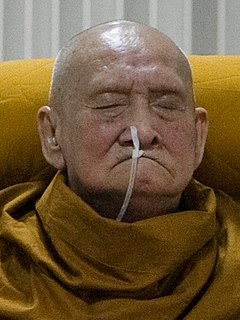
Somdet Phra Sangharaja Chao Krommaluang Vajirañāṇasaṃvara, né Charoen Khachawat and dharma name Suvaḍḍhano, was the 19th Supreme Patriarch of Thailand. He was appointed to the position in 1989 by King Bhumibol Adulyadej. He turned 100 in October 2013, and died later the same month.

A wat is a type of Buddhist temple and Brahminical temple in Cambodia, Laos, East Shan State, Yunnan and Thailand. The word wat is a thai word that was borrowed from Sanskrit vāṭa, meaning 'enclosure'. The term has varying meanings in each region, sometimes referring to a specific type of government-recognised or large temple, other times referring to any Buddhist or Brahminical temple.

The Sanam Luang National Dhamma Studies Examination Curriculum is a three tier system used throughout Thailand for training in theoretical knowledge about Buddhism. The curriculum is run in tandem with the nine-tiered Pahrian Thamm curriculum for Pali Studies. The curriculum offers two slightly different sets of examination papers
- Nak Thamm designed for the ordained Sangha i.e. Buddhist monks, novices and nuns)
- Thammaseuksa designed for lay Buddhists.
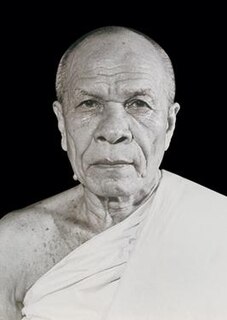
Luang Pu Sodh Candasaro, also known as Phramongkolthepmuni, was the abbot of Wat Paknam Bhasicharoen from 1916 until his death in 1959. He founded the Thai Dhammakāya school in the early 20th century. As the former abbot of Wat Paknam Bhasicharoen, he is often called Luang Pu Wat Paknam, meaning 'the Venerable Father of Wat Paknam'. He became a well-known meditation master during the interbellum and the Second World War, and played a significant role in developing Thai Buddhism during that period. He is considered by the Dhammakaya tradition to have rediscovered Vijja Dhammakaya, a meditation method believed to have been used by the Buddha himself. Since the 2000s, some scholars have pointed out that Luang Pu Sodh also played an important role in introducing Theravāda Buddhism in the West, a point previously overlooked.
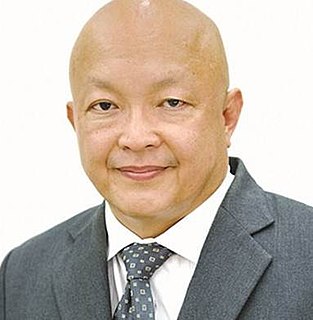
Mano Laohavanich is a Thai politician, former professor of Buddhism at Thammasat University, and former Buddhist monk. He is most famous for his public statements against Wat Phra Dhammakaya, the largest Buddhist temple in Thailand.

Somdet Phra Ariyavongsagatanana IX, born Amborn Prasatthapong, is the current Supreme Patriarch of Thailand. Ordained as a Bhikkhu monk in 1948 with the dharma name of Ambaro, he is a monk of the Dhammayuttika Nikaya order. In 2008 he was appointed abbot of Wat Ratchabophit in Bangkok. In 2017 he was appointed Supreme Patriarch by King Vajiralongkorn, succeeding Nyanasamvara Suvaddhana who died in 2013.
Phra Malai Kham Luang is the royal version of a Thai legendary poem of the Sri Lankan Arhat Maliyadeva whose stories are popular in Thai Theravada Buddhism. The vernacular version is known as Phra Malai Klon Suat. Phra Malai is the subject of numerous palm-leaf manuscripts, folding books, and artworks. His story, which includes concepts such as reincarnation, merit, and Buddhist cosmology, was a popular part of Thai funeral practices in the nineteenth century.















